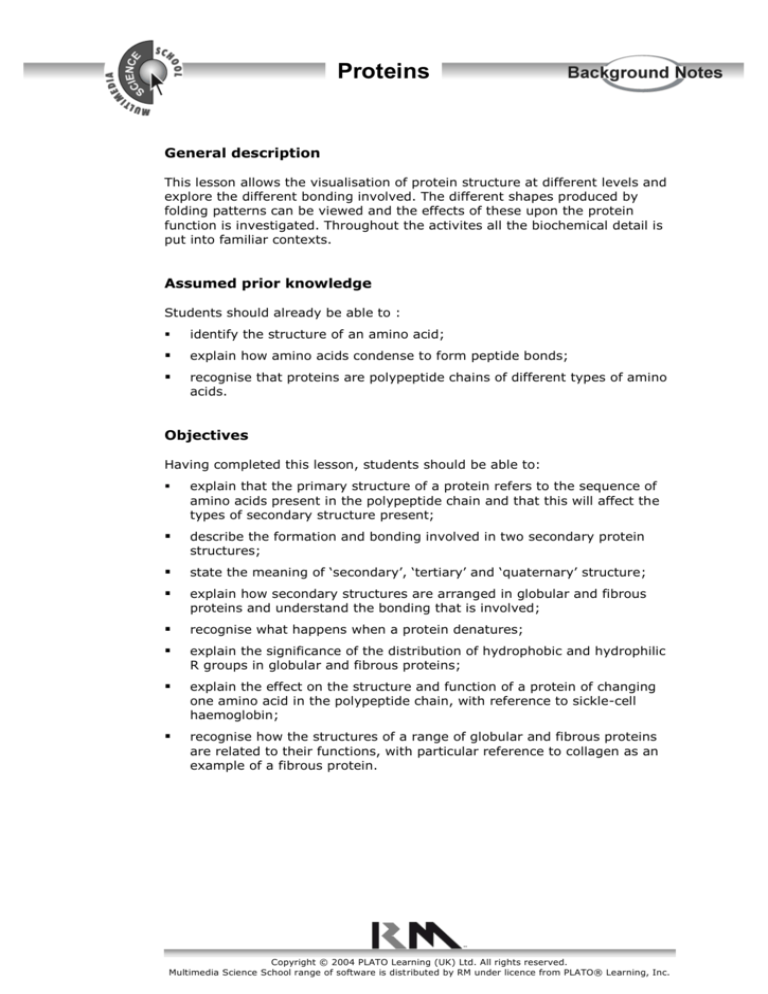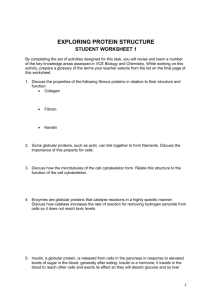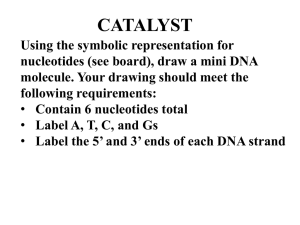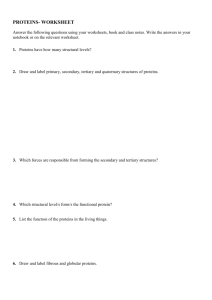
Proteins
General description
This lesson allows the visualisation of protein structure at different levels and
explore the different bonding involved. The different shapes produced by
folding patterns can be viewed and the effects of these upon the protein
function is investigated. Throughout the activites all the biochemical detail is
put into familiar contexts.
Assumed prior knowledge
Students should already be able to :
identify the structure of an amino acid;
explain how amino acids condense to form peptide bonds;
recognise that proteins are polypeptide chains of different types of amino
acids.
Objectives
Having completed this lesson, students should be able to:
explain that the primary structure of a protein refers to the sequence of
amino acids present in the polypeptide chain and that this will affect the
types of secondary structure present;
describe the formation and bonding involved in two secondary protein
structures;
state the meaning of ‘secondary’, ‘tertiary’ and ‘quaternary’ structure;
explain how secondary structures are arranged in globular and fibrous
proteins and understand the bonding that is involved;
recognise what happens when a protein denatures;
explain the significance of the distribution of hydrophobic and hydrophilic
R groups in globular and fibrous proteins;
explain the effect on the structure and function of a protein of changing
one amino acid in the polypeptide chain, with reference to sickle-cell
haemoglobin;
recognise how the structures of a range of globular and fibrous proteins
are related to their functions, with particular reference to collagen as an
example of a fibrous protein.
Copyright © 2004 PLATO Learning (UK) Ltd. All rights reserved.
Multimedia Science School range of software is distributed by RM under licence from PLATO® Learning, Inc.
Proteins
Activity descriptions
Activity 1
Polypeptide chains
Students are shown a range of different proteins with animations of their
different functions. They can arrange amino acids in different sequences
in order to appreciate the range of possible primary structures. They then
view the formation of alpha helix and beta-pleated sheets, represented
from difference sequences of amino acids. By zooming in on these
structures students can see how hydrogen bonding stabilises the structure
formed and that it does not involve the R groups. Finally students
investigate different parts of a protein molecule and find that these parts
are composed of different types of secondary structure.
Activity 2
Globular proteins
Through a simple animation, students observe the relationship between
secondary protein structures and the tertiary structure of a simple
globular protein. They closely examine the significance of the
arrangement of hydrophobic and hydrophilic R groups in globular proteins
and the types of bonding between R groups. The effect of denaturing a
globular protein is animated to demonstrate the breakage of bonds
between R groups and the exposure of hydrophobic groups.
An animated sequence illustrates the structure of haemoglobin as an
example of quaternary structure and an interactive exercise allows the
students to replace glutamic acid with valine to create sickle-cell
haemoglobin. The effects of this point mutation are then seen on the
protein, as well as on the red blood cells.
Activity 3
Fibrous proteins
In this activity, the relationship between secondary protein structure and
the structure of collagen molecules and fibrils is explored through
animation. The arrangement of hydrophobic and hydrophilic R groups is
examined and linked to the functions of some key fibrous proteins.
Differentiation
This lesson guides students through the progressive concepts in a gradual
manner, with the different levels of protein structure gradually built up. The
different types of bonding involved are emphasised throughout. Through the
activities a visual impression of key ideas relating to protein structure is
gained.
Less able students may confuse the difference between peptide bonding, the
hydrogen bonding between adjacent amino acid groups in secondary structure
Copyright © 2004 PLATO Learning (UK) Ltd. All rights reserved.
Multimedia Science School range of software is distributed by RM under licence from PLATO® Learning, Inc.
Proteins
and the bonding between R groups in tertiary structure. These differences are
carefully introduced to clarify the differences and continue to be emphasised
throughout. Less able students will also benefit from seeing the clear spatial
relationships between different parts of the polypeptide chain and the bonds
holding them together.
The significance of the bonding of R groups and the effects of breaking these
bonds creates a clear visual image that can later be applied to the study of
enzymes. Similarly, the arrangement of hydrophobic and hydrophilic R groups
is made very clear, so that its significance in terms of function is easily
understood.
More able students will be challenged by the section on sickle-cell
haemoglobin, as this requires a more in-depth study of a particular protein. It
also provides an interesting context for the precision of protein structure
related to function. The animation dealing with the structure of collagen
explains this complex protein in considerable detail and will also challenge
more able students.
Copyright © 2004 PLATO Learning (UK) Ltd. All rights reserved.
Multimedia Science School range of software is distributed by RM under licence from PLATO® Learning, Inc.









